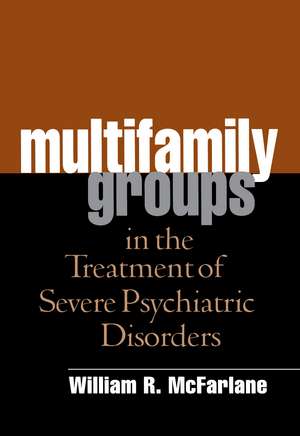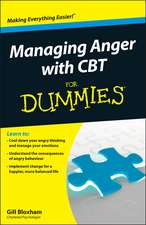Multifamily Groups in the Treatment of Severe Psychiatric Disorders
Autor William R. McFarlaneen Limba Engleză Paperback – 21 oct 2004
This volume presents a proven psychoeducational therapy approach for persons with severe mental illness and their families. Pioneering schizophrenia treatment developer William R. McFarlane first lays out the theoretical and empirical foundations of the multifamily model. Chapters coauthored with other leading clinician-researchers then provide detailed how-to instructions for forming groups; implementing educational and problem-solving interventions; managing clinical, relationship, and functional issues that may arise; and integrating psychoeducation with other forms of treatment. Also addressed are applications of the model--some described here for the first time--to a variety of disorders other than schizophrenia, including bipolar disorder, depression, obsessive-compulsive disorder, borderline personality disorder, and medical illness.
Preț: 306.46 lei
Preț vechi: 322.59 lei
-5% Nou
Puncte Express: 460
Preț estimativ în valută:
58.65€ • 61.15$ • 48.74£
58.65€ • 61.15$ • 48.74£
Carte tipărită la comandă
Livrare economică 21 martie-04 aprilie
Preluare comenzi: 021 569.72.76
Specificații
ISBN-13: 9781593850951
ISBN-10: 1593850956
Pagini: 403
Dimensiuni: 152 x 229 x 26 mm
Greutate: 0.66 kg
Ediția:1
Editura: Guilford Publications
Colecția Guilford Press
ISBN-10: 1593850956
Pagini: 403
Dimensiuni: 152 x 229 x 26 mm
Greutate: 0.66 kg
Ediția:1
Editura: Guilford Publications
Colecția Guilford Press
Public țintă
Postgraduate, Professional, and Professional Practice & DevelopmentCuprins
Contents
I. Theoretical and Empirical Foundations: The Scientific Basis of Multifamily Group Treatment
1. The Psychobiology of Schizophrenia
2. Families, Social Networks, and Schizophrenia, Ellen P. Lukens and William R. McFarlane
3. The Therapeutic Social Network: A Healing Community
4. Empirical Studies of Outcome in Multifamily Groups
II. The Practice of Multifamily Group Treatment in Schizophrenia: A Psychoeducational Approach to Developing a Healing Social Network
5. An Overview of Psychoeducational Multifamily Group Treatment
6. Joining with Families and Patients, William R. McFarlane, Susan Gingerich, Susan M. Deakins, Edward Dunne, Bonnie T. Horen, and Margaret Newmark
7. Educating Families: A Multifamily Workshop on Schizophrenia, William R. McFarlane, Susan Gingerich, Susan M. Deakins, Edward Dunne, Bonnie T. Horen, and Margaret Newmark
8. The Initial Sessions of a Psychoeducational Multifamily Group: Forming a Healing Network, William R. McFarlane, Susan Gingerich, Susan M. Deakins, Edward Dunne, Bonnie T. Horen, and Margaret Newmark
9. Problem-Solving in Multifamily Groups: A Psychoeducational Approach to Treatment and Rehabilitation, William R. McFarlane, Susan Gingerich, Susan M. Deakins, Edward Dunne, Bonnie T. Horen, and Margaret Newmark
III. Applications in Other Disorders and Contexts: Expanding the Range and Relevance of Multifamily Group Treatment
10. Family-Aided Assertive Community Treatment, William R. McFarlane and Susan M. Deakins
11. Training Staff of Supportive Housing Programs in Principles and Practices of Psychoeducation: Creating a Family-Like Social Environment, Bonnie T. Horen and Jules M. Ranz
12. Multifamily Groups for Bipolar Illness, David A. Moltz and Margaret Newmark
13. Multifamily Group Treatment for Major Depressive Disorder, Gabor I. Keitner, Laura M. Drury, Christine E. Ryan, Ivan W. Miller, William H. Norman, and David A. Solomon
14. Multifamily Psychoeducational Treatment of Borderline Personality Disorder, Cynthia B. Berkowitz and John G. Gunderson
15. Multifamily Behavioral Treatment of Obsessive-Compulsive Disorder, Barbara Van Noppen and Gail Steketee
16. Application of Multifamily Groups in Chronic Medical Disorders, Sandra Gonzalez and Peter Steinglass
17. Implementing Multifamily Groups in the Real World: The New York State and Ohio Training and Dissemination Programs, Lisa Dixon and Edward Dunne
Afterword, C. Christian Beels
I. Theoretical and Empirical Foundations: The Scientific Basis of Multifamily Group Treatment
1. The Psychobiology of Schizophrenia
2. Families, Social Networks, and Schizophrenia, Ellen P. Lukens and William R. McFarlane
3. The Therapeutic Social Network: A Healing Community
4. Empirical Studies of Outcome in Multifamily Groups
II. The Practice of Multifamily Group Treatment in Schizophrenia: A Psychoeducational Approach to Developing a Healing Social Network
5. An Overview of Psychoeducational Multifamily Group Treatment
6. Joining with Families and Patients, William R. McFarlane, Susan Gingerich, Susan M. Deakins, Edward Dunne, Bonnie T. Horen, and Margaret Newmark
7. Educating Families: A Multifamily Workshop on Schizophrenia, William R. McFarlane, Susan Gingerich, Susan M. Deakins, Edward Dunne, Bonnie T. Horen, and Margaret Newmark
8. The Initial Sessions of a Psychoeducational Multifamily Group: Forming a Healing Network, William R. McFarlane, Susan Gingerich, Susan M. Deakins, Edward Dunne, Bonnie T. Horen, and Margaret Newmark
9. Problem-Solving in Multifamily Groups: A Psychoeducational Approach to Treatment and Rehabilitation, William R. McFarlane, Susan Gingerich, Susan M. Deakins, Edward Dunne, Bonnie T. Horen, and Margaret Newmark
III. Applications in Other Disorders and Contexts: Expanding the Range and Relevance of Multifamily Group Treatment
10. Family-Aided Assertive Community Treatment, William R. McFarlane and Susan M. Deakins
11. Training Staff of Supportive Housing Programs in Principles and Practices of Psychoeducation: Creating a Family-Like Social Environment, Bonnie T. Horen and Jules M. Ranz
12. Multifamily Groups for Bipolar Illness, David A. Moltz and Margaret Newmark
13. Multifamily Group Treatment for Major Depressive Disorder, Gabor I. Keitner, Laura M. Drury, Christine E. Ryan, Ivan W. Miller, William H. Norman, and David A. Solomon
14. Multifamily Psychoeducational Treatment of Borderline Personality Disorder, Cynthia B. Berkowitz and John G. Gunderson
15. Multifamily Behavioral Treatment of Obsessive-Compulsive Disorder, Barbara Van Noppen and Gail Steketee
16. Application of Multifamily Groups in Chronic Medical Disorders, Sandra Gonzalez and Peter Steinglass
17. Implementing Multifamily Groups in the Real World: The New York State and Ohio Training and Dissemination Programs, Lisa Dixon and Edward Dunne
Afterword, C. Christian Beels
Notă biografică
William R. McFarlane, MD, is Professor of Psychiatry at the University of Vermont and Director of Research and former Chairman, Department of Psychiatry, Maine Medical Center. Previously, he was Director of the Biosocial Treatment Research Division of the New York State Psychiatric Institute and Associate Professor in the Department of Psychiatry, College of Physicians and Surgeons, Columbia University. His main interests are in developing and testing family and psychosocial treatments for major mental illnesses and determining their application in the public sector. Dr. McFarlane has published more than 40 articles and book chapters, as well as one previous book, and has served on the Board of Directors of the American Orthopsychiatric Association, on the Council of the Association for Clinical Psychosocial Research, and as President of the Maine Psychiatric Association.
Recenzii
“I use this book as the primary text in a class for master’s-degree-seeking students who are preparing to work collaboratively in primary care medical settings. The book provides an excellent resource for these students, who need models of treatments that can harness the power of the family system and the social network in helping patients and families manage chronic and severe psychiatric conditions. Detailed, concise, and easily understandable, this book represents the state of the art in evidence-based practice.”--Richard J. Bischoff, PhD, Director, Marriage and Family Therapy Program, University of Nebraska-Lincoln
William R. McFarlane has known for more than three decades that families have the power to deal with problems caused by a member struggling with serious mental illness. He developed multifamily groups as the tool to harness this power. Multifamily groups are opportunities for family members to swap information and share support, so that all involved can withstand the challenges of psychiatric disability. In this single authoritative book, McFarlane and his colleagues have captured the methods and strengths of the approach. This is 'must' reading and an exceptional resource for service providers.--Patrick W. Corrigan, PsyD, Center for Psychiatric Rehabilitation, University of Chicago
Education of patients and their caregivers about mental disorders, and effective integrated biomedical and psychosocial treatment, are now well established as major components of effective mental health programs. McFarlane and his colleagues have pioneered and refined the multifamily group approach as an excellent means of providing long-term structured problem solving to facilitate clinical and social recovery from major disorders. This volume provides a clear description of the theory, practice, efficacy, and dissemination of the multifamily educational approach for psychotic disorders, as well as its integration with other evidence-based treatments.--Ian R. H. Falloon, MD, DSc, Department of Psychiatry, University of Auckland, New Zealand
William R. McFarlane's work on developing the multifamily group intervention has been a leap forward in the treatment of serious mental illness. This extensive form of family psychoeducation results in reduced relapse rates as well as improved quality of life for both patients and family members. In this book, which includes contributions from a number of professionals using multifamily methods, Dr. McFarlane offers a virtually encyclopedic guide to the approach. It is essential reading for anyone working with people with serious mental illness.--Dale L. Johnson, PhD, Department of Psychology, University of Houston; Past President, National Alliance for the Mentally Ill
-William R. McFarlane has known for more than three decades that families have the power to deal with problems caused by a member struggling with serious mental illness. He developed multifamily groups as the tool to harness this power. Multifamily groups are opportunities for family members to swap information and share support, so that all involved can withstand the challenges of psychiatric disability. In this single authoritative book, McFarlane and his colleagues have captured the methods and strengths of the approach. This is 'must' reading and an exceptional resource for service providers.--Patrick W. Corrigan, PsyD, Center for Psychiatric Rehabilitation, University of Chicago
Education of patients and their caregivers about mental disorders, and effective integrated biomedical and psychosocial treatment, are now well established as major components of effective mental health programs. McFarlane and his colleagues have pioneered and refined the multifamily group approach as an excellent means of providing long-term structured problem solving to facilitate clinical and social recovery from major disorders. This volume provides a clear description of the theory, practice, efficacy, and dissemination of the multifamily educational approach for psychotic disorders, as well as its integration with other evidence-based treatments.--Ian R. H. Falloon, MD, DSc, Department of Psychiatry, University of Auckland, New Zealand
William R. McFarlane's work on developing the multifamily group intervention has been a leap forward in the treatment of serious mental illness. This extensive form of family psychoeducation results in reduced relapse rates as well as improved quality of life for both patients and family members. In this book, which includes contributions from a number of professionals using multifamily methods, Dr. McFarlane offers a virtually encyclopedic guide to the approach. It is essential reading for anyone working with people with serious mental illness.--Dale L. Johnson, PhD, Department of Psychology, University of Houston; Past President, National Alliance for the Mentally Ill
[This book] deals with an area and a methodology that were little recognized even a few years ago and that are now recognized as being of primary importance for clinical practice, teaching, and research. Deserves a place on the bookshelf of every mental health professional.
--Psychiatric Services, 9/9/2004ƒƒMcFarlane has written a book that every clinical director, group program coordinator, and agency-based group therapist should read. He provides details of what he and his colleagues have done and lays out a path to a new and important area for group therapy in the treatment of severe and chronic illnesses.
--International Journal of Group Psychotherapy, 9/9/2004ƒƒProvides information so detailed that the second portion of the book functions as a treatment manual....This volume is exceptionally accessible, and therefore, suitable for students interested in working with schizophrenic patients and those interested in better understanding the biological, psychological and social processes influencing the course and symptomatology of schizophrenia.
--The Clinical Psychologist, 9/9/2004Descriere
This volume presents a proven psychoeducational therapy approach for persons with severe mental illness and their families. Pioneering schizophrenia treatment developer William R. McFarlane first lays out the theoretical and empirical foundations of the multifamily model. Chapters coauthored with other leading clinician-researchers then provide detailed ""how-to"" instructions for forming groups; implementing educational and problem-solving interventions; managing clinical, relationship, and functional issues that may arise; and integrating psychoeducation with other forms of treatment. Also addressed are applications of the model--some described here for the first time--to a variety of disorders other than schizophrenia, including bipolar disorder, depression, obsessive-compulsive disorder, borderline personality disorder, and medical illness.
















